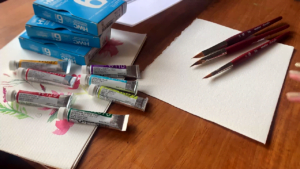You can store watercolor paintings in a dry, cool, and dark place. Ideally, they should be stored horizontally in a portfolio or acid-free sleeve to protect them from dust, environmental elements like moisture, and physical damage.

Watercolor paintings have been widely popular and cherished for centuries.
However, the delicate nature of watercolors means they require extra care and attention when it comes to storage to maintain their vibrancy and longevity. If not stored correctly, watercolor paintings can fade or become damaged. Exposure to light, heat, humidity, pollutants, and pests are some of the factors that can contribute to the deterioration of paintings.
So, in this article, you will discover how to store watercolor paintings properly that is unframed. From framing to choosing the right storage materials, I’ll share all that you must know to protect your beautiful artwork.
Materials Needed To Store Watercolor Paintings Properly

1. Acid-free Paper
Acid-free paper is essential for separating the painting from other materials and preventing contact with harmful chemicals. Make sure you choose an acid-free paper specifically designed to store watercolor artworks to avoid color fading or deterioration.
2. Archival Sleeves
Archival sleeves are clear plastic sleeves that protect the painting from dust, dirt, and other pollutants. They are designed to be acid-free, and some also offer protection from ultraviolet rays to prevent fading.
3. Flat Storage
Storing watercolor paintings flat in a file folder helps prevent smudging, formation of wrinkle, and brittleness. It's important to use a flat storage container, large enough to accommodate the painting without bending or folding.
4. Acid-free Mat Board
Acid-free mat board provides extra protection to the painting and creates a professional look for framing. Just ensure that you select an acid-free mat board designed for artwork to prevent any discoloration or deterioration.
5. Archival Storage Box
An archival storage box is designed to store and protect artwork from light, moisture, and pollutants. So, choose a box that is acid-free, sturdy, and properly sized to accommodate the painting.
Each of these materials is important as they offer protection from different environmental elements that can damage the watercolor painting.
Preparing The Painting For Storage
1. Ensure The Watercolor Painting Is Completely Dry
Before storing your painting, it's essential to make sure that it's completely dry. If the painting is not dry, it can stick to other surfaces, and the colors may run, causing damage.
Tip
Leave the painting out in a well-ventilated area until it's completely dry. You could even use a hair dryer to speed up the process, but you’ll have to be careful not to ruin the painting with too much heat and pressure.
2. Remove Any Debris
Use a clean, lint-free cloth or a soft brush to remove any dirt or debris that may have accumulated on the watercolor painting. But avoid using any cleaning products or water, as they can damage the painting.
3. Protect The Surface Of The Painting
Cover the surface with a sheet of acid-free paper or glassine envelope. This will prevent any accidental smudging or transfer of color while the painting is being stored.
4. Place The Painting In An Archival Sleeve
Once the painting is covered, carefully slide it into an archival sleeve. Make sure the sleeve is slightly larger than the painting so that it doesn’t touch its surface.
5. Store The Painting Horizontally
Watercolor paintings should always be stored horizontally and lie flat in a storage container. Again, check that the container is large enough to accommodate the painting without bending or folding it.
6. Store The Container In A Cool And Dry Place
Store the container in a cool, dry place away from direct sunlight, moisture, and extreme temperatures. Avoid storing the container in areas that are prone to humidity or fluctuating temperatures, such as attics or basements.

Choosing The Right Storage Location
Choosing the right storage location is crucial if you want to preserve watercolor paintings, as they are vulnerable to environmental factors. The storage location should provide optimal conditions that protect the artwork from potential damage, deterioration, and aging caused by environmental factors, such as temperature, humidity, lighting, and air quality.
That said, prolonged exposure to direct sunlight can cause the colors to fade and deteriorate, while fluctuations in temperature and humidity can cause warping, cracking, and mold growth.
When choosing a storage location for watercolor paintings, consider the following factors:
1. Temperature
The ideal temperature for storing paintings is between 60 and 75°F. Fluctuations in temperature can cause expansion and contraction of the painting, leading to cracking and warping. So, avoid storing the painting in areas that experience extreme temperature fluctuations, such as attics and basements.
2. Humidity
Watercolor paintings are susceptible to high humidity, which can cause bacteria and mold growth, buckling, and warping. The ideal humidity range for storing paintings is between 45 and 55%. As such, damp areas, such as basements, bathrooms, or areas with high moisture content, are not recommended for storage.
3. Lighting
Watercolor paintings are vulnerable to light damage. Direct sunlight and bright artificial light can cause fading, discoloration, and yellowing. To prevent light damage, store the painting in a dark, dry location, away from windows. Also, avoid using an incandescent light bulb or a fluorescent lamp as it can emit UV radiation, causing a chemical reaction on your paintings.
4. Air Quality
The storage location should be free from pollutants, dust, and debris that can settle on the surface of the painting and cause damage. So, do not store the painting in areas with high traffic.
Besides, consider the following tips to find the best location for storing watercolor paintings:
- Choose a location that provides stable temperature and humidity conditions, such as a closet or a room with a controlled environment.
- Store paintings horizontally or roll them up with acid-free tissue paper to prevent cracking, warping, or folding.
- Avoid using plastic wrap or bags as they can trap moisture and cause mold growth.
Proper Storage Techniques
1. Maintain Cleanliness While Painting
It is no secret that cleanliness eliminates dust - in fact, that’s pretty obvious! However, not many know that ensuring cleanliness during your drawing and painting sessions can go a long way when storing your artwork. This is because dirt, dust, smoke, and food residue can cause damage to your work of art.
So, it is important to clean your hands thoroughly before beginning your painting session. Avoid touching the surface of the painting paper, as this can cause water resistance and uneven results. Additionally, it is important to keep all painting supplies, including the canvas, water, acrylic paint, and paper, free of fingerprints and oil.
Tip
Clean your supplies before and after each use to ensure they remain free of dirt or residue.
2. Frame Your Unframed Watercolor Paintings
Albeit an additional step, it can help enhance the durability of your paintings. Given below are some materials you can consider for framing your unframed paintings:
A. Mountboards
It is crucial to use mountboards when for framing, as they provide enough gap/space between the glass and the artwork. Otherwise, the painting's quality can degrade if it comes into contact with the glass, causing damage to the surface and leading to condensation buildup.
B. UV Filtering Glass
I recommend using acrylic or UV-filtering glass rather than ordinary glass for framing. Although these specialized glasses do not provide complete protection from UV rays, they can significantly increase the longevity of your artwork compared to regular glass.
C. Acid-free Materials
All art materials must be acid-free, including the masking tape, framing tape, glue, mountboards, and backing boards. The type of adhesive used is particularly important, as acidic variants can turn your painting brown.
While many people use wood backing boards, it is not recommended as most woods contain acidic lignin. If a foam board is needed, it should be the archival option rather than the acidic one.
3. Label Your Artwork
When preparing to store your watercolor paintings, consider packaging and labeling each cardboard box to facilitate easy identification of the paintings without having to open multiple boxes. For better organization, group similar paintings in the same box, preferably acid-free packaging. Using colored boxes or markers for different containers can also aid in this process.
4. Never Touch The Surface
Accidentally touching the surface of your watercolor painting can result in damage to the quality of the artwork. To avoid this, it is recommended to wear cotton gloves when handling the painting, particularly when moving or storing it. This will fingerprints on the surface that may cause contamination.
5. Varnish Your Paintings
To protect your dried watercolor painting, I recommend using an archival varnish. It is important to wait until the painting is completely dry before applying the varnish and to use a gloss varnish for the first coat instead of matte or satin.
Basically, the varnish creates a transparent layer that helps protect the painting from moisture and improves the elasticity of the paper, allowing it to stretch on the canvas.
6. Handle With Care
When handling a watercolor painting, always use clean, dry hands to avoid transferring oils or dirt onto the surface. Use two hands to lift and move the painting, and avoid bending or folding the paper.
Storing watercolor paintings in a portfolio is a great way to protect them from dust, smoke, soot, light, and other environmental factors. However, choose a portfolio that is designed for artwork storage and is made of acid-free and archival-quality textiles. Fortunately, there are various types of suitable portfolio cases on the market today. I recommend PVC-free, acid-free, crystal-clear, or lignin-free top-loading polypropylene pocket sheets with thick gauge acid-free black mounting paper backing sheets. If the portfolio has straps or ties, secure them tightly to prevent the paintings from shifting. Thereafter, store the portfolio in a cool, dry, and dark place. I recommend checking on your stored watercolor paintings periodically, ideally at least once every six months. But if you live in an area with fluctuating temperature and humidity levels, you must check them more frequently. Storing watercolor paper has always been a challenge for artists. However, selecting high-quality watercolor paper, such as conservation grade paper or archival paper with acid-free properties, can help to ensure its longevity. Pests like cockroach, silverfish, etc., are attracted to damp and dirty places, so ensure your paintings are stored in a clean and dry area, free from moisture, dirt, and soil. You should also store them in airtight storage boxes, preferably made of plastic. Alternatively, you can use insect repellents and seek the services of a professional pest control company. As such, I do not recommend keeping your paintings in the kitchen, which is more prone to pests, smoke, etc. And if you have a personal art gallery at home, avoid smoking in the area.FAQs Related To Storing Watercolor Painting

Conclusion
Whether you choose to store your paintings flat in archival sleeves, in a portfolio, or framed on a wall, make sure to use high-quality materials. Also, monitor the conditions of the storage room, and check on your paintings periodically.
By taking these steps, you can ensure that your watercolor paintings remain in excellent condition for years to come. So, don't wait any longer - start taking care of your artwork today and enjoy its beauty for many years to come!
If you liked this article, check out my latest one on “Watercolor Painting Ideas.”
